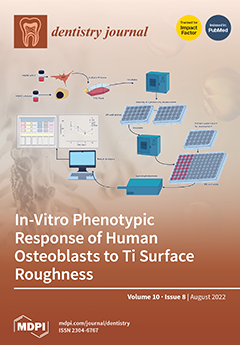Gingivitis and periodontitis are inflammatory disorders caused by dental plaque and calculus. These disorders often lead to tooth loss if not treated properly. Although antibiotics can be used, it is hard to treat them due to the difficulty in supplying effective doses of
[...] Read more.
Gingivitis and periodontitis are inflammatory disorders caused by dental plaque and calculus. These disorders often lead to tooth loss if not treated properly. Although antibiotics can be used, it is hard to treat them due to the difficulty in supplying effective doses of antibiotics to lesion areas and side effects associated with long-term use of antibiotics. In the present study, attempts were made to provide in vitro and in vivo evidence to support anti-inflammatory activities of TEES-10
®, a mixture of ethanol extracts of
Ligularia stenocephala (LSE) and
Secale cereale L. sprout (SCSE) toward gingivitis and periodontitis by performing the following experiments. TEES-10
® with a ratio of 6:4 (LSE:SCSE) showed the best effects in both stimulating the viability and inhibiting the cytotoxicity. In in vitro experiments, TEES-10
® showed an ability to scavenge 2,2-diphenyl-1-picrylhydrazyl and superoxide radicals and remove ROS generated in periodontal ligament cells treated with lipopolysaccharide. TEES-10
® also enhanced the viability of stem cells from human exfoliated deciduous teeth and stimulated the osteogenic differentiation of deciduous teeth cells. In in vivo experiments using rats with induced periodontitis, TEES-10
® significantly decreased inflammatory cell infiltration and the numbers of osteoclasts, increased alveolar process volume and the numbers of osteoblasts, decreased serum levels of IL-1β and TNF-α (pro-inflammatory cytokines), and increased serum levels of IL-10 and IL-13 (anti-inflammatory cytokines). These results strongly support the theory that TEES-10
® has the potential to be developed as a health functional food that can treat and prevent gingival and periodontal diseases and improve dental health.
Full article






